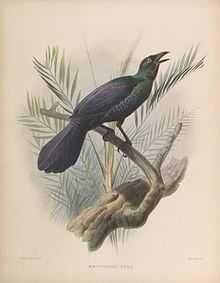Glossy-mantled manucode
| Glossy-mantled manucode | |
|---|---|
 | |
| Conservation status | |
| Scientific classification | |
| Kingdom: | Animalia |
| Phylum: | Chordata |
| Class: | Aves |
| Order: | Passeriformes |
| Family: | Paradisaeidae |
| Genus: | Manucodia |
| Species: | M. ater |
| Binomial name | |
| Manucodia ater (Lesson, 1830) | |
| Synonyms | |
|
Manucodia atra | |
The glossy-mantled manucode (Manucodia ater) is a species of bird-of-paradise.
The glossy-mantled manucode was the first bird of paradise encountered by the French naturalist René-Primevère Lesson, the first westerner to see live wild birds of paradise.
It is widely distributed throughout the lowlands of New Guinea and nearby islands. The diet consists mainly of fruits, figs and arthropods.
Widespread and common throughout its large range, the glossy-mantled manucode is evaluated as Least Concern on the IUCN Red List of Threatened Species. It is listed on Appendix II of CITES.
San Diego Zoo has the only captive individual of this species outside of New Guinea.
Description
The glossy-mantled manucode is medium-sized, around 42 cm long, glossed green, blue and purple black with a red iris, black bill, long graduated tail and somewhat elongated upper breast and neck feathers. Both sexes are similar. The female is a slightly smaller than the male. In appearance, the glossy-mantled manucode resembles and is difficult to distinguished from its nearest relatives, the crinkle-collared and jobi manucodes.
Subspecies
- Manucodia ater alter
- Manucodia ater atra
- Manucodia ater subalter
References
- ↑ BirdLife International (2012). "Manucodia ater". IUCN Red List of Threatened Species. Version 2013.2. International Union for Conservation of Nature. Retrieved 26 November 2013.
- Clench, Mary H. 1978. Trachael Elongation in Birds-of-Paradise. Condor 80 (4): 423-430.
External links
| Wikispecies has information related to: Manucodia atra |
